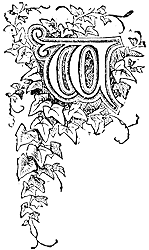 |

ITHIN two miles of Droitwich stands Westwood House, in the centre of a large and well-wooded park, with a lake of some size at the east of the house, and lovely avenues of grand old trees radiating from it. The front of the mansion commands a view of this lake. Nash, in his History of Worcester, thus describes it:-
"Westwood House consists of a square building, from each corner of which projects a wing in the form of a parallelogram, and turreted in the style of the Chateau de Madrid, Paris, or Holland House."
Situated on a rising ground, and encircled with masses of glorious old trees, this ancient dwelling forms the centre of a picture of beauty that has few equals. The house greatly resembles a Norman chateau; it is built of brick with stone quoins and parapets. The body of the house is square, and three storeys high; the saloon occupies the first floor, and is lighted by large bay windows. Wings project in a line from the centre of each corner of the house, and communicate, by doors on each floor, with the central building. At some distance from each wing, yet opposite to them, are small square towers that were once connected by walls with the main building; but the walls have been removed, or fallen, and the towers now stand alone.
The gate-house is immediately in front of the house at some little distance in advance; the gate has a red brick lodge on each side of it with ornamental gables and pinnacles. The gate between them is ornamented with the heraldic bearings of the family, the mullet or star of five points, and below them the garbs or wheat-sheaves. These bearings are also sculptured on the parapets, the wheatsheaves forming the pilasters and the mullets the balusters. The timber-work over the gate, with its high pointed roof and small pinnacle, is very picturesque.
The stables and servants' offices are at a short distance in the rear of the house, and where the kitchen garden now stands was originally a nunnery. No remains exist of it, but in digging, stone coffins have sometimes been found there.
Eustachia de Say and her son Osbert Fitz Hugh gave the church here to the Abbey de Frontevaud, in Normandy, where many of our kings are buried. Soon after a small priory was erected here, dedicated to the Blessed Virgin, for six nuns of the Benedictine order; it ultimately numbered eighteen sisters. An abbess of this nunnery, Isabella, died under excommunication for having accepted Clement VII. as Pope.
The last prioress, Joyce Acton, received at the dissolution, in 1553, an annual pension of ten pounds.
After the dissolution Henry VIII. granted Westwood, with its lands, to Sir John Pakyngton, knight, in whose descendants it still continues.
The Pakyugtons resided at Hampton Lovet, but that house was so much damaged during the civil wars that they moved to Westwood, which had been built in the reign of Elizabeth. They enlarged and repaired the house, and probably erected the stone portico - purely Italian in taste. There is an open balustrade on each side of the steps, and over the centre arch is a figure seated on an eagle.
The hall is an oblong room possessing no features of interest; we pass through it to the library, which contains many rare and valuable works.
The principal apartments, besides the hall and library, are reached by a splendid staircase of carved oak, supporting globes on Corinthian capitals. By this stairway the saloon is reached. It is a grand room, with a double bay window, immediately over the hall; its walls are lined with fine old tapestry of the Elizabethan age, and it has a magnificent fireplace, decorated with the royal arms. From the window of this room a grand view is obtained over a most beautiful and undulating country. The lake, the radiating avenues, and the ancient oaks add to its beauty. There is, indeed, all over Worcestershire a soft beauty of landscape that is very bewitching.
Sir John Pakyngton, Bart., knight of the shire in the reign of Charles I., was a strong Royalist, and was tried for. his life by the Parliament; his estates were sequestered, and he was greatly plundered, but he ultimately compounded with the Parliamentary Committee for £5,000. Sir John Pakyngton's house was the refuge of learned men in those sad times when the king and Parliament were at war. Dr. Hammond found shelter here, and Bishops Morley, Fenn, Gunning, and others were received and treated with the greatest hospitality. In concert with these good and great men, Dorothy, Lady Pakyngton - the good Lady Pakyngton as she was called - is supposed to have written the "Whole Duty of Man," one of the most popular of religious works in its day. It has been asserted that the original MS. in the handwriting of this lady, with interlined corrections by Bishop Fell, was in the possession of her daughter, Mrs. Ayre, of Bampton, who declared it to be the production of her mother, adding that she was also the authoress of "The Decay of Christian Piety," and other very popular religious works.
At the Revolution the tried hospitality of Westwood House was extended to those who scrupled to take the oath of allegiance to William of Orange, and Dean Hickes wrote several of his important works at Westwood.
|
 |